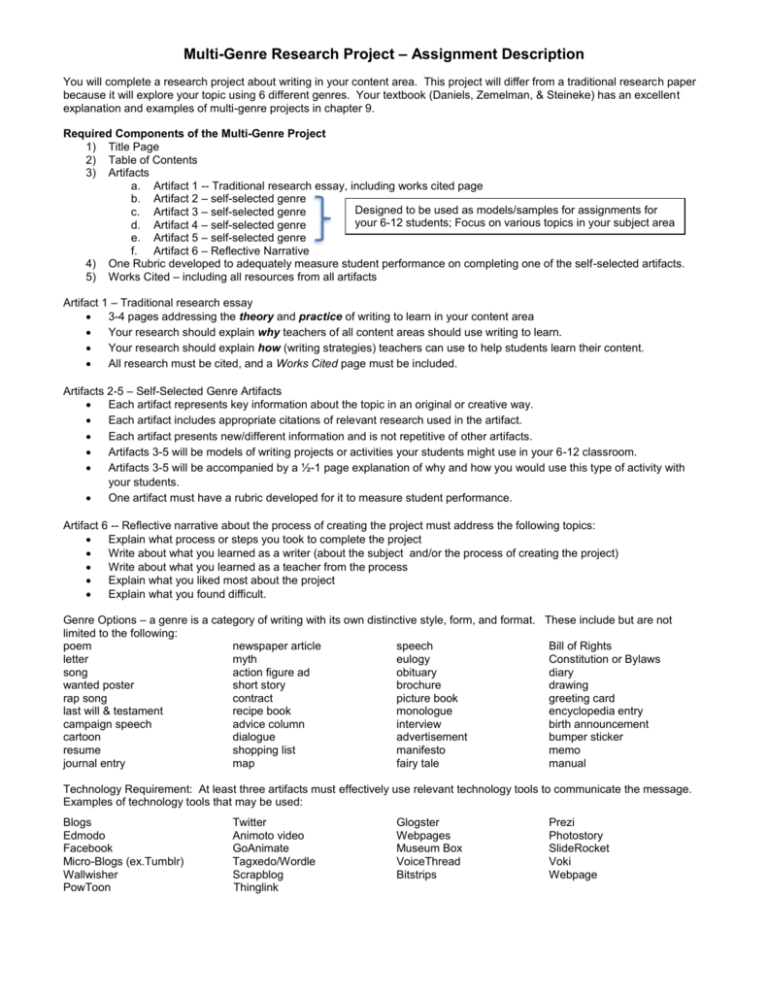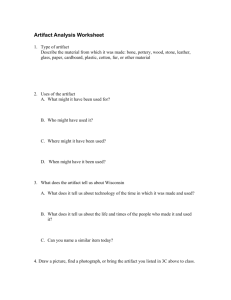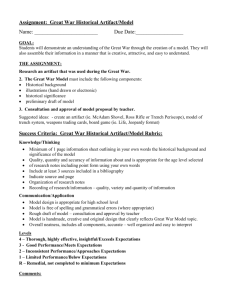MultiGenre Project and Rubric
advertisement

Multi-Genre Research Project – Assignment Description You will complete a research project about writing in your content area. This project will differ from a traditional research paper because it will explore your topic using 6 different genres. Your textbook (Daniels, Zemelman, & Steineke) has an excellent explanation and examples of multi-genre projects in chapter 9. Required Components of the Multi-Genre Project 1) Title Page 2) Table of Contents 3) Artifacts a. Artifact 1 -- Traditional research essay, including works cited page b. Artifact 2 – self-selected genre Designed to be used as models/samples for assignments for c. Artifact 3 – self-selected genre your 6-12 students; Focus on various topics in your subject area d. Artifact 4 – self-selected genre e. Artifact 5 – self-selected genre f. Artifact 6 – Reflective Narrative 4) One Rubric developed to adequately measure student performance on completing one of the self-selected artifacts. 5) Works Cited – including all resources from all artifacts Artifact 1 – Traditional research essay 3-4 pages addressing the theory and practice of writing to learn in your content area Your research should explain why teachers of all content areas should use writing to learn. Your research should explain how (writing strategies) teachers can use to help students learn their content. All research must be cited, and a Works Cited page must be included. Artifacts 2-5 – Self-Selected Genre Artifacts Each artifact represents key information about the topic in an original or creative way. Each artifact includes appropriate citations of relevant research used in the artifact. Each artifact presents new/different information and is not repetitive of other artifacts. Artifacts 3-5 will be models of writing projects or activities your students might use in your 6-12 classroom. Artifacts 3-5 will be accompanied by a ½-1 page explanation of why and how you would use this type of activity with your students. One artifact must have a rubric developed for it to measure student performance. Artifact 6 -- Reflective narrative about the process of creating the project must address the following topics: Explain what process or steps you took to complete the project Write about what you learned as a writer (about the subject and/or the process of creating the project) Write about what you learned as a teacher from the process Explain what you liked most about the project Explain what you found difficult. Genre Options – a genre is a category of writing with its own distinctive style, form, and format. These include but are not limited to the following: poem newspaper article speech Bill of Rights letter myth eulogy Constitution or Bylaws song action figure ad obituary diary wanted poster short story brochure drawing rap song contract picture book greeting card last will & testament recipe book monologue encyclopedia entry campaign speech advice column interview birth announcement cartoon dialogue advertisement bumper sticker resume shopping list manifesto memo journal entry map fairy tale manual Technology Requirement: At least three artifacts must effectively use relevant technology tools to communicate the message. Examples of technology tools that may be used: Blogs Edmodo Facebook Micro-Blogs (ex.Tumblr) Wallwisher PowToon Twitter Animoto video GoAnimate Tagxedo/Wordle Scrapblog Thinglink Glogster Webpages Museum Box VoiceThread Bitstrips Prezi Photostory SlideRocket Voki Webpage EDU 436 Rubric for Multi-Genre Project Name _______________________________________ Date Completed_____________ Students will complete a multi-genre research project focusing on writing-to-learn in their chosen content area (English, math, science, or social studies). This project will have elements of traditional research, but it will go beyond the traditional research paper (artifact 1) by exploring the topic using at least 6 different genres. Refer to description in syllabus for details and directions. Rating: Exceptional corresponds to an A (90-100). Performance is outstanding; significantly above the usual expectations. Proficient corresponds to a grade of B- to B+ (80-89%). Skills and standards are at the level of expectation. Basic corresponds to a C to C+ (70-79%). Skills and standards are acceptable but improvements are needed to meet expectations well. Novice corresponds to a D to C- (50-69%). Performance is weak; the skills or standards are not sufficiently demonstrated at this time. 0 This criterion is missing or not in evidence. Criteria 0 Novice 1-9 Basic 10-11 Proficient 12-14 Exceptional 15-16 0 Novice 1-9 Basic 10-11 Proficient 12-14 Exceptional 15-16 0 Novice 1-9 Basic 10-11 Proficient 12-14 Exceptional 15-16 0 Novice 1-5 Basic 6 Proficient 7 Exceptional 8 The research paper demonstrates the writers ability to organize ideas around a clear and coherent thesis statement (MG ENG 7.1, Not in LOM) The research paper incorporates relevant details and ample textual evidence to support the thesis statement. (MG EG 7.2, Not in LOM) The paper is 3-4 pages in length. Artifact # 1 The Research Paper Components The paper expertly addresses writing in the content area and provides convincing information regarding 1) the theory and 2) the practice (strategies) of using writing to facilitate learning in the content area The use of references indicates substantial research. References are from sources considered professionally reliable (from peer-reviewed literature, scholarly journals, etc). At least 5 different resources are appropriately cited in APA format. The paper demonstrates [the writer’s] proficient use of postsecondary level standard written English (e.g., varied word choice and syntax, semantics, language conventions). [MG ENG 7.3 Not in LOM] Artifacts 2-5 (Self-Selected Genres) Each of 4 self-selected artifacts demonstrates 1) content area mastery, 2) creativity and originality 3) understanding of topic, audience, and purpose, and 4) quality writing (including effective word choice, sentence fluency, voice, and conventions). Each artifact is accompanied by a ½ page explanation of how and why you would use this with your students. Artifact # 2 Artifact # 3 Artifact # 4 Artifact # 5 Rubric Artifact # 7 Reflective Narrative One Rubric is developed for at least one artifact. The rubric adequately measures K-12 student performance on completing this type of artifact The Reflective Narrative effectively explains the author’s process in completing the project including both enjoyable and challenging aspects. Narrative discusses what the author Reflective narrative discusses what the author learned about the topic and process, demonstrating deep understanding of writing as a tool for learning. Reflective narrative discusses what the author learned as a teacher regarding using writing as a tool for learning in the content area. Integration of Relevant Technology Three or more artifacts effectively use relevant technology tools to communicate the information. The message is enhanced by the technology selected for each of the artifacts: 0 Novice 1-5 Basic 7 Proficient 8 Exceptional 9-10 0 Novice 1-5 Basic 7 Proficient 8 Exceptional 9 0 Novice .25 Basic .50 Proficient .75 Exceptional 1 1st Artifact Using Technology: 2nd Artifact Using Technology: 3rd Artifact Using Technology: Organizational Elements All required components are present including the following: title page, table of contents, research essay, 5 genre artifacts, reflective narrative, and works cited page. Each artifact contributes to a well-developed central idea. All components are organized to achieve unity and coherence. Florida State Writing Standards Throughout the Multi-Genre project, the student demonstrated the ability to write informative/explanatory texts to examine a topic and convey ideas, concepts, and information through the selection, organization, and analysis of content. (Florida Writing Standard LAFS.8.W.1.2) Throughout the Multi-Genre project, the student wrote narratives to develop real or imagined experiences or events using effective techniques, well-chosen details, and well-structured event sequences. (Florida Writing Standard LAFS.8.W.1.3) Throughout the 7 artifacts of the Multi-Genre project, the student produced clear and coherent writing which the development, organization, and style are appropriate to task, purpose, and audience. (Florida Writing Standard LAFS.8.W.2.4) Throughout the Multi-Genre project, the student developed and strengthened writing as needed by planning, revising, editing, rewriting, or trying a new approach, focusing on how well purpose and audience have been addressed. (Florida Writing Standard LAFS.8.W.2.5) During the Multi-Genre project, the student used technology, including the internet, to produce and publish writing and to interact and collaborate with others. (Florida Writing Standard LAFS.8.W.2.6) While writing the 7 artifacts for the Multi-Genre project, the student conducted short research projects to answer a question (including a self-generated question), drawing on several sources and generating additional related, focused questions that allow for multiple avenues of exploration (Florida Writing Standard LAFS.8.W.3.7) The student gathered relevant information from multiple print and digital sources, using search terms effectively, assessed the credibility and accuracy of each source, and integrated the information while avoiding plagiarism and following a standard format for citation (Florida Writing Standard LAFS.8.W.3.8) The student drew evidence from literary or informational texts to support analysis, reflection, and research (Florida Writing Standard LAFS.8.W.3.9) Throughout the multi-genre project, the student wrote routinely over extended time frames (time for research, reflection, and revision) and shorter time frames (a single sitting or a day or two) for a range of tasks, purposes, and audiences. (Florida Writing Standard LAFS.8.W.4.10) Comments: Total ______ of 250




